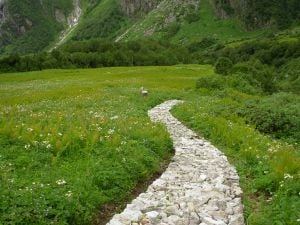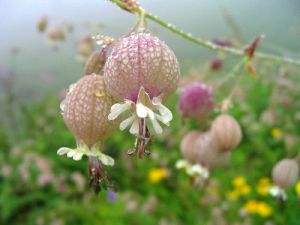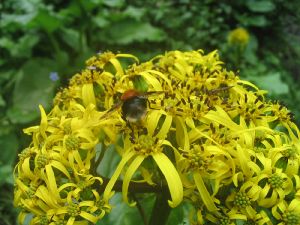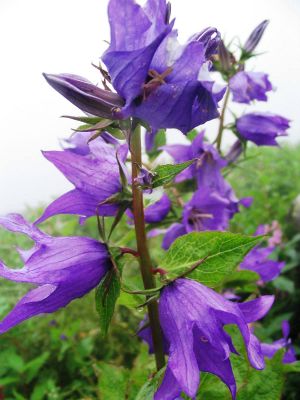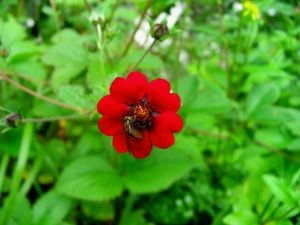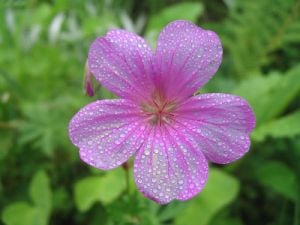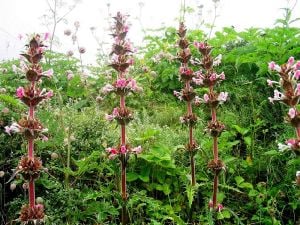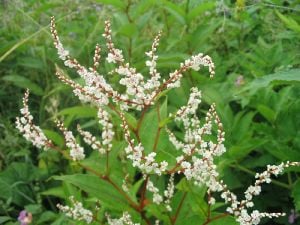Valley of Flowers National Park
| Nanda Devi and Valley of Flowers National Parks* | |
|---|---|
| UNESCO World Heritage Site | |
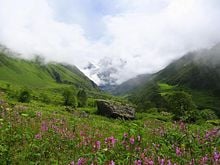
| |
| State Party | |
| Type | Natural |
| Criteria | vii, x |
| Reference | 335 |
| Region** | Asia-Pacific |
| Inscription history | |
| Inscription | 1988 (12th Session) |
| Extensions | 2005 |
| * Name as inscribed on World Heritage List. ** Region as classified by UNESCO. | |
Valley of Flowers National Park is an Indian national park since 1982, nestled high in the West Himalayas. The park stretches over an expanse of 87.50 square kilometers (33.78 sq mi). The Valley of Flowers has enshrined in Hindu Mythology. It won international renown during the past century, brought to the world's attention by the work of Frank S. Smythe. Home to a variety of endangered plants and medicinal plants, the region displays the best example of the West Himalaya biogeographic zone. The majority of flowers include Orchids, Poppies, Primulas, Calendulas, Daisies and Anemones as well as alpine forests of Birch and Rhododendron.
The richly diverse area serves as home to rare and endangered animals, including the Asiatic Black Bear, Snow Leopard, Brown Bear and Blue Sheep. The region lies within the Western Himalayas Endemic Bird Area. The Indian government has banned settlements and animal grazing in the park. It is open only from June to October due to the heavy snow fall. The gentle landscape of the Valley of Flowers National Park compliments the rugged mountain wilderness of Nanda Devi National Park. Together they encompass a unique transition zone between the mountain ranges of the Zanskar and Great Himalaya. The park has won fame for its meadows of endemic alpine flowers and outstanding natural beauty. UNESCO designated the Valley of Flowers National Park a World Heritage Site along with Nanda Devi National Park.
Description
The Valley of Flowers is an outstandingly beautiful high-altitude Himalayan valley that has been acknowledged as such by renowned mountaineers and botanists in literature for over a century and in Hindu mythology for much longer. Its gentle landscape, breath-takingly beautiful meadows of alpine flowers and ease of access complement the rugged, mountain wilderness for which the inner basin of Nanda Devi National Park has won acclaim.[1]
The Valley of Flowers diverse alpine flora, representative of the West Himalaya biogeographic zone, has international importance. The rich diversity of species reflects the valley’s location within a transition zone between the Zaskar and Great Himalaya ranges to the north and south, respectively, and between the Eastern and Western Himalaya flora. A number of plant species are internationally threatened, several have not been recorded from elsewhere in Uttarakhand and two have not been recorded in Nanda Devi National Park. The diversity of threatened species of medicinal plants is higher than has been recorded in other Indian Himalayan protected areas. The entire Nanda Devi Biosphere Reserve lies within the Western Himalayas Endemic Bird Area (EBA). Seven restricted-range bird species are endemic to this part of the EBA.[2]
The Republic of India declared The Valley of Flowers a national park in 1982. That part of Uttarakhand, in the upper reaches of Garhwal, proves inaccessible through much of the year. The area lies on the Zanskar range of the Himalayas with the highest point in the national park being Gauri Parbat at 6,719 meters (22,040 ft) above sea level.[3]
Settlements have been prohibited in the national park and grazing in the areas banned. Open only in summer between June and October, heavy snow covers the region during the rest of the year. Getting to the Valley of Flowers requires a trek of about 17 kilometers (11 mi). The nearest major town is Joshimath in Garhwal, which has convenient road connections from railheads such as Hardwar and Dehradun, both about 270 kilometers (170 mi) from Joshimath.
From Joshimath, a vehicle can be hired to take you to within 17 kilometers (11 mi) of the park, to the settlement of Gobindghat. The route from Joshimath to the Valley of Flowers goes along the main road to Badrinath; roughly midway along this road, a minor road branches off to Gobindghat, the roadhead for the Valley. From Gobindghat, a trek of 14 kilometers (8.7 mi) brings hikers to the tiny settlement of Ghangaria. Valley of flowers is about 2 kilometers (1.2 mi) from this village. Hemkund Sahib sits around five kilometers from Ghangaria.
History
Frank S. Smythe, mountaineer, explorer, and botanist introduced the Valley to the world as the Valley of Flowers. He had camped in the valley for several weeks in the monsoon of 1937 and performed valuable exploratory work.[4] Smythe authored a book called "The Valley of Flowers" which unveiled the beauty and floral splendors of the valley and thus threw open the doors of this verdant jewel to nature-enthusiasts all over the world.[5]
In 1939 Miss Margaret Legge, a botanist deputed by the Botanical Gardens of Edinburgh arrived at the valley for further studies. While she was traversing some rocky slopes to collect flowers, she slipped off and perished. Her sister later visited the valley and erected a memorial on the spot where locals buried her. The heart-felt memorial stands as of 2008.
Fauna and Flora
The park serves as home to Tahr, Snow Leopard, Musk Deer, Red Fox, Common Langur, Bharal, Serow, Himalayan Black Bear, Himalayan Brown Bear, Pica (Mouse Hare) and a huge variety of butterflies. Among the important birds and Pheasant are the Himalayan Golden Eagle, Griffon Vulture, Snow Partridge, Himalayan Snow Cock,Himalayan Monal, Snow Pigeon, and Sparrow Hawk.
Flowers, mostly Orchids, Poppies, Primulas, Calendulas, Daisies and Anemones carpet the park. Alpine forests of Birch and Rhododendron cover parts of the park's area.
Species
| No. | Name of Flowers | Time of flowering |
| 1. | Rhododendron arboreum | February-June |
| 2. | Primula denticuleta | April-July |
| 3. | Iris kemaonensis | June-July |
| 4. | Fritillaria roylei | June-July |
| 5. | Lilium oxypetalum | June-July |
| 6. | Arisaema costautum | June-July |
| 7. | Thermopsisa barbata | June-July |
| 8. | Rosa macrophylla | June-July |
| 9. | Caltha palustris | June-July |
| 10. | Fragaria nubicola | May-July |
| 11. | Saxifraga roylei | July-August |
| 12. | Anemone obtusiloba | June-August |
| 13. | Cypripedium himalaicum | June-August |
| 14. | Rheum australe | July-August |
| 15. | Phlomis oracteosa | June-August |
| 16. | Hackelia uncinata | June-August |
| 17. | Senecio jacquemotiamus | August-September |
| 18. | Ligularia amplexicaulis | July-August |
| 19. | Morina longifolia | July-September |
| 20. | Geum elatum | July-August |
| 21. | Geranium wallichianum | July-August |
| 22. | Impatiense sulcata | July-August |
| 23. | Meconopsis aculeata | July-August |
| 24. | Delphenium roylei | July-August |
| 25. | Aconitum hookeri | August-September |
| 26. | Thalictrum reniforme | July-September |
| 27. | Potentilla atrosanguinea | July-September |
| 28. | Sedum ewersii | August-September |
| 29. | Dactylorhiza hatagirea | June-July |
| 30. | Bistorta affinis | August-September |
| 31. | Stachys sericee | August-September |
| 32. | Nepeta connata | August-September |
| 33. | Pedicularis hoffmeistri | July-August |
| 34. | Swertia hookeri | August-September |
| 35. | Gentiana ornata | August-September |
| 36. | Gaultheria erichophy | August-September |
| 37. | Codonopsis affinis | August-September |
| 38. | Angelica cyelocarpa | July-September |
| 39. | Leontopodium jacotianum | July-September |
| 40. | Saussurea fastuosa | July-September |
| 41. | Campanula latitotia | August-September |
| 42. | Cyananthus lobotus | August-September |
| 43. | Sassurea obvallata | August-September |
| 44. | Cremanthodium ellisii | July-September |
| 45. | Anaphalis triplineruts | July-September |
| 46. | Inula grandiflora | August-September |
| 47. | Aster albescens | July-September |
| 48. | Selinium tenuifolium | August-September |
| 49. | Heracleum pinnatum | August-September |
| 50. | Epilobium latisperma | August-September |
| 51. | Silene setisperma | August-September |
| 52. | Arenaria griffithii | August-September |
| 53. | Corydalis junecea | August-September |
| 54. | Erigerono multiradiatus | August-September |
| 55. | Polygonum molle | August-September |
| 56. | Himalayan Blue Poppy | July-September |
| 57. | Codonopsis viridis | July-August |
| 58. | Origanus vulgare | July-August |
| 59. | Hackelia uncinata | July-August |
| 60. | Salvia hins/lanata | July-August |
| 61. | Smilacina purpurea/oleracea | June-July |
| 62. | Viola biflora | June-August |
| 63. | Rhodiola heterodonta | July-August |
| 64. | Epilohium latifolium | July-August |
| 65. | Cotoneaster integrifolius | July-August |
| 66. | Dubyaea hispida | August-September |
| 67. | Saussurea costus | July-August |
| 68. | Ligularia fiseheri | July-August |
| 69. | Androsace museoidea | July-August |
| 70. | Eritrichium conum | July-August |
| 71. | Lindelofi anchusoides | July-August |
| 72. | Thymus linearis | June-August |
| 73. | Rheum webbianum | June-August |
| 74. | Megacorpaea polyandra | June-August |
| 75. | Trillidium govanianum | June-August |
| 76. | Satyrium nepoleanse | June-August |
| 77. | Podophyllum hexaneum | June-August |
| 78. | Picrorhiza kurrooa | June-August |
| 79. | Polygonatum multiflorum | June-August |
See Also
- Nanda Devi National Park
- Himalayas
- Climate of India
- Nanda Devi
- Nepal
- Kashmir Region
- Tibetan people
- Tibet
Notes
- ↑ James Workman. Pragmatic solutions: an assessment of progress, 2005. (Gland, Switzerland: IUCN, 2006)
- ↑ R. S. Ambasht and Navin K. Ambasht. Modern trends in applied terrestrial ecology. (New York: Kluwer Academic/Plenum Publishers, 2002), 125
- ↑ Jagdish Kaur. Himalayan pilgrimages and the new tourism. (New Delhi: Himalayan Books, 1985), 62.
- ↑ Harish Kapadia. Meeting the mountains. (New Delhi: Indus Pub. Co., 1998), 121.
- ↑ F. S. Smythe. The valley of flowers. (London: Hodder and Stoughton, 1938)
ReferencesISBN links support NWE through referral fees
- Ambasht, R. S., and Navin K. Ambasht. 2002. Modern trends in applied terrestrial ecology. New York: Kluwer Academic/Plenum Publishers. ISBN 9780306473326.
- Kaur, Jagdish. 1985. Himalayan pilgrimages and the new tourism. New Delhi: Himalayan Books. ISBN 9788170020004.
- Kapadia, Harish. 1998. Meeting the mountains. New Delhi: Indus Pub. Co. ISBN 9788173870859.
- Smythe, F. S. 1938. The valley of flowers. London: Hodder and Stoughton. OCLC 341916.
- Workman, James. 2006. Pragmatic solutions: an assessment of progress, 2005. Gland, Switzerland: IUCN. ISBN 9782831709246.
External links
All links retrieved May 3, 2023.
| |||||||
| Andaman & Nicobar Islands | Campbell Bay • Galathea • Mahatma Gandhi • Mt. Harriet Island • Middle Button Island • North Button Island • Rani Jhansi • Saddle Peak • South Button Island |
| Andhra Pradesh | Kasu Brahmananda Reddy • Mahavir Harina Vanasthali • Mrugavani • Sri Venkateswara) |
| Arunachal Pradesh | Mouling • Namdapha |
| Assam | Dibru-Saikhowa • Kaziranga • Manas Nameri • Orang |
| Bihar | Valmiki |
| Chhattisgarh | Indravati • Kanger Ghati |
| Goa | Mollem |
| Gujarat | Blackbuck • Gir • Gulf of Kutch • Vansda |
| Haryana | Kalesar • Sultanpur |
| Himachal Pradesh | Great Himalayan • Pin Valley |
| Jammu & Kashmir | Dachigam • Hemis • Kishtwar • Salim Ali |
| Jharkhand | Betla |
| Karnataka | Anshi • Bandipur • Bannerghatta • Kudremukh • Nagarhole |
| Kerala | Eravikulam • Mathikettan Shola • Periyar • Silent Valley |
| Madhya Pradesh | Bandhavgarh • Fossil • Kanha • Madhav • Panna • Pench Sanjay • Satpura • Van Vihar |
| Maharastra | Chandoli • Gugamal • Navegaon • Pench • Sanjay Gandhi • Tadoba |
| Manipur | Keibul Lamjao • Sirohi |
| Meghalaya | Balphakram • Nokrek |
| Mizoram | Murlen • Phawngpui |
| Nagaland | Intanki |
| Orissa | Bhitarkanika • Simlipal |
| Rajasthan | Darrah • Desert • Keoladeo • Ranthambhore • Sariska |
| Sikkim | Khangchendzonga |
| Tamil Nadu | Guindy • Gulf of Mannar • Indira Gandhi • Palani Hills • Mudumalai • Mukurthi |
| Uttar Pradesh | Nawabganj • Dudhwa |
| Uttarakhand | Corbett • Gangotri • Govind • Nanda Devi • Rajaji • Valley of Flowers |
| West Bengal | Buxa • Gorumara • Neora Valley • Singalila • Sundarbans |
| National Parks • Protected areas of India • Ministry of Environment and Forests (India) | |
Credits
New World Encyclopedia writers and editors rewrote and completed the Wikipedia article in accordance with New World Encyclopedia standards. This article abides by terms of the Creative Commons CC-by-sa 3.0 License (CC-by-sa), which may be used and disseminated with proper attribution. Credit is due under the terms of this license that can reference both the New World Encyclopedia contributors and the selfless volunteer contributors of the Wikimedia Foundation. To cite this article click here for a list of acceptable citing formats.The history of earlier contributions by wikipedians is accessible to researchers here:
The history of this article since it was imported to New World Encyclopedia:
Note: Some restrictions may apply to use of individual images which are separately licensed.
